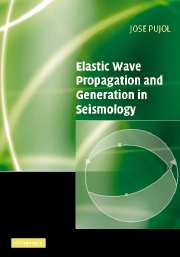Book contents
- Frontmatter
- Contents
- Preface
- Acknowledgements
- 1 Introduction to tensors and dyadics
- 2 Deformation. Strain and rotation tensors
- 3 The stress tensor
- 4 Linear elasticity – the elastic wave equation
- 5 Scalar and elastic waves in unbounded media
- 6 Plane waves in simple models with plane boundaries
- 7 Surface waves in simple models – dispersive waves
- 8 Ray theory
- 9 Seismic point sources in unbounded homogeneous media
- 10 The earthquake source in unbounded media
- 11 Anelastic attenuation
- Hints
- Appendices
- Bibliography
- Index
1 - Introduction to tensors and dyadics
Published online by Cambridge University Press: 12 November 2009
- Frontmatter
- Contents
- Preface
- Acknowledgements
- 1 Introduction to tensors and dyadics
- 2 Deformation. Strain and rotation tensors
- 3 The stress tensor
- 4 Linear elasticity – the elastic wave equation
- 5 Scalar and elastic waves in unbounded media
- 6 Plane waves in simple models with plane boundaries
- 7 Surface waves in simple models – dispersive waves
- 8 Ray theory
- 9 Seismic point sources in unbounded homogeneous media
- 10 The earthquake source in unbounded media
- 11 Anelastic attenuation
- Hints
- Appendices
- Bibliography
- Index
Summary
Introduction
Tensors play a fundamental role in theoretical physics. The reason for this is that physical laws written in tensor form are independent of the coordinate system used (Morse and Feshbach, 1953). Before elaborating on this point, consider a simple example, based on Segel (1977). Newton's second law is f = ma, where f and a are vectors representing the force and acceleration of an object of mass m. This basic law does not have a coordinate system attached to it. To apply the law in a particular situation it will be convenient to select a coordinate system that simplifies the mathematics, but there is no question that any other system will be equally acceptable. Now consider an example from elasticity, discussed in Chapter 3. The stress vector T (force/area) across a surface element in an elastic solid is related to the vector n normal to the same surface via the stress tensor. The derivation of this relation is carried out using a tetrahedron with faces along the three coordinate planes in a Cartesian coordinate system. Therefore, it is reasonable to ask whether the same result would have been obtained if a different Cartesian coordinate system had been used, or if a spherical, or cylindrical, or any other curvilinear system, had been used. Take another example. The elastic wave equation will be derived in a Cartesian coordinate system.
- Type
- Chapter
- Information
- Publisher: Cambridge University PressPrint publication year: 2003
- 1
- Cited by



